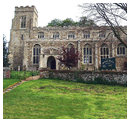  |
 |
 |
 |
 |
| Mon 08 Dec 2025 |

The History Of Saint Nicholas' Church DenstonMonumentsIn the nave between the benches in a stone with a brass of a woman and a shield above the head. The inscription has been removed. Another stone near the pulpit has also had its inscription removed and the absence of a coat of arms suggests that it may be that of a prominent though unenobled parishioner. In the chancel is a fine brass of Henry and Margaret Everard, the head of Henry Everard resting upon his crested and mantled helmet, and an inscription, now gone, copied by Davy in 1814, read: "Orate pro aiabus Henrici Everard Armigeri et Margaretae usoris ejus quae Margareta obiit 6 die Augusti Anno Dni 1524: cujus animae propitietur deus. Amen." Within the sanctuary are stones. reading from south to north, to Elizabeth Jones, mother of John Robinson, 1699; Clement Raye, B.D., 1695 and Mary his wife, 1680 (Clement Raye was a former rector); then come two stones, the brass inscriptions lost and no place for coats of arms; these like the stone in the nave are probably those of prominent parishioners, or possibly priests. In the north aisle, before the holy table, is another stone without its brass, similar to those within the sanctuary. The original stone high altar, retaining two of its five consecration crossets, is set in the floor near by. The usual length of these altar stones was ten feet, so that this has probably been shortened by about two feet, accounting for the presence of only two crosses. The central cross was probably covered by the brass inscription, which reads: Here lyeth buryed under this stone the bodye of William Burd esquire who had to wife Mirable and was married to her 40 years, and had issue by her v sonnes and vii daughters, which William deceased the xii day of June in the yere of our Lord God, 1591, being of ye age of 69 yeres." Rhen Davy visited the church in 1814 there was a coat of arms also on the stone. There are in this aisle as in the south aisle many monuments to the Robinson family, who were connected by marriage with the family of Clive of India. To the south of the high altar is an altar tomb to members of the Robinson family, with inscriptions commemorating those who died elsewhere. On the north of the high altar is an altar tomb with two shrouded cadavers beneath. In 1814 when Davy visited the church, the appearance of the tomb seems to have been as it is today, with the canopy above the figures covered with a large slab of marble, on which were once figures in brass of a man and a women and three shields above and below them and round the edge of the slab an inscription in brass. There are traces of painting on the head of one of the cadavers. The ancient tiles round them are similar to some near the High Altar. The arcading on which the slab rests seems to be much later in date. 'The slab is noticeably larger than the base on which the cadavers rest but in spite of that there is a possibility that it is a composite tomb of the donors of the chantry. The arcading would then have been of a different design. It could also be that the slab was placed in position later and that the cadavers originally had no canopy but were on a plinth similar to that of John Baret's tomb in St. Mary's, Bury St. Edmunds. Whatever the appearance of the original tomb was, it is likely from its position, which is that of the greatest honour, that the donors John and Katharine Denston are buried here. Before the Reformation one of the Easter ceremonies was the placing of the Crucifix from the high altar in an Eastern sepulchre. This was usually a wooden structure with hangings and it was placed on a suitable tomb to the north of the high altar, though occasionally special features were constricted for the reception of the Crucifix. The Clopton tomb in Long Melford church was used for the Easier sepulchre and is in a similar position. Tombs with cadavers are found in a number of churches and are mainly of the fifteenth century when preoccupation with the physical aspects of death is exemplified in realistic sculpture and in such paintings as the "Three Living and the Three Dead." |

